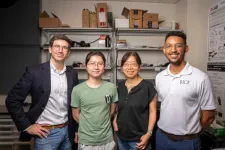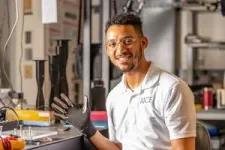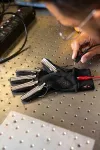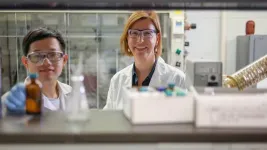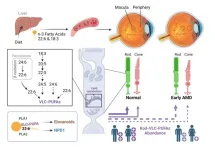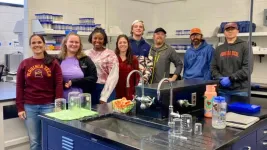(Press-News.org) HOUSTON – (Sept. 11, 2023) A new material that packs deadly heat for viruses on its outer surface while staying cool on the reverse side could transform the way we make and use personal protective equipment (PPE), cutting down the pollution and carbon footprint associated with current materials and practices.
The composite, textile-based material developed by Rice University engineers uses Joule heating to decontaminate its surface of coronaviruses like SARS-CoV-2 in under 5 seconds, effectively killing at least 99.9% of viruses. Wearable items made from the material can handle hundreds of uses with the potential for a single pair of gloves to prevent nearly 20 pounds of waste that would have resulted from discarded single-use nitrile gloves.
“The surge in magnitude of PPE waste and problems caused by supply chain shortages during the pandemic made us realize the need for reusable PPE,” said Marquise Bell, a Rice mechanical engineering graduate student who is the lead author on a study on the material published in ACS Applied Materials and Interfaces. “This work paves the way for a systemic shift away from single-use disposable PPE.
“The best part is you don’t even need to take off the gloves or other protective garments in order to clean them. This material allows you to decontaminate in seconds, so you can get back to the task at hand.”
Using electrical current, the material rapidly heats up its outer surface to temperatures above 100 degrees Celsius (212 Fahrenheit), while remaining close to normal body temperature on the reverse side near the user’s skin where it reaches a maximum of about 36 C (97 F).
“The device has to get hot enough to effectively kill viruses, but not so hot that it causes burns or discomfort for the user,” Bell said. “We included safety mechanisms to make sure the latter doesn’t happen.”
Compared to other decontamination methods, dry heat tends to be both reliable and less likely to damage protective equipment. However, making wearables that heat up to adequate temperatures quickly has required a lot of work.
“Our lab has looked a lot at the thermal inactivation of viruses,” said Daniel Preston, an assistant professor of mechanical engineering who is an author on the study. “We started during the pandemic with support from a National Science Foundation grant, trying to understand the mechanism by which these viruses are inactivated and how it's accelerated at higher temperatures.”
The earlier research helped lead to the design of the material. Yizhi Jane Tao , a professor of biosciences whose virology lab conducted experiments to confirm the material’s powers of self-decontamination, said she was impressed by how closely experimental data matched predictions.
“We’re very happy that we can contribute our expertise toward this new material,” Tao added.
Kai Ye, a graduate student in the Tao lab who helped with the research, said the gloves handled “the infectivity test” well and promise to protect against other similar viruses.
Considering the temperature difference between its outer and inner surfaces, the material is surprisingly supple and lightweight ⎯ a feat that feeds directly into Bell’s research focus on smart textile materials.
“I study the mechanics, thermodynamics and heat transfer processes of soft goods that can be layered for use in wearable assistive devices,” said Bell, who is funded by a NASA Space Technology Graduate Research Opportunities fellowship. “Spacesuits, for instance, are made up of many layers: The innermost layers are where a lot of the functionality happens, close to the human body. Then you have a lot of thermally insulating layers in between, topped off with firmer, more protective layers on the outside of the suit.
“I look at how we can use smart textile materials and integrate them into spacesuits to decrease their weight while adding multifunctionality.”
Bell participated in this year’s NextProf Nexus, a competitive workshop that is part of a “nationwide effort to strengthen and diversify the next generation of academic leaders in engineering,” according to the program.
Co-organized by the University of Michigan, University of California, Berkeley and Georgia Institute of Technology, NextProf Nexus helps prepare engineering students from underrepresented groups for navigating the academic job market, from researching open positions and funding opportunities to crafting effective application materials.
This year, NextProf was hosted by Georgia Tech and welcomed its largest cohort ⎯ roughly 70 participants out of more than 300 applicants.
“It's becoming more real that I'm now in the latter part of my Ph.D.,” Bell said. “The workshop was a more comprehensive, in-depth experience than I initially expected, and I’m really glad I had the opportunity to participate.”
The research was supported by the National Science Foundation (2030023), the Welch Foundation (C-1565), NASA (80NSSC21K1276), the National GEM Consortium, the Rice Academy of Fellows and the Shared Equipment Authority.
-30-
This release can be found online at news.rice.edu.
Follow Rice News and Media Relations via Twitter @RiceUNews.
Peer-reviewed paper:
“Rapid In Situ Thermal Decontamination of Wearable Composite Textile Materials” | ACS Applied Materials and Interfaces | DOI: 10.1021/acsami.3c09063
Authors: Marquise Bell, Kai Ye, Te Faye Yap, Anoop Rajappan, Zhen Liu, Yizhi Jane Tao and Daniel Preston
https://doi.org/10.1021/acsami.3c09063
Image downloads:
https://news-network.rice.edu/news/files/2023/09/0923_ACS-Applied-Materials_MBwdevice_LG.jpg
CAPTION: Marquise Bell, a Rice University mechanical engineering graduate student, is lead author on a study published in ACS Applied Materials and Interfaces and a participant in the 2023 NextProf Nexus workshop. (Photo by Gustavo Raskosky/Rice University)
https://news-network.rice.edu/news/files/2023/09/0923_ACS-Applied-Materials_researchteam_LG.jpg
CAPTION: Daniel Preston (from left), Kai Ye, Yizhi Jane Tao and Marquise Bell (Photo by Gustavo Raskosky/Rice University)
https://news-network.rice.edu/news/files/2023/09/0923_ACS-Applied-Materials_hothandLG.jpg
CAPTION: A glove made of a material designed at Rice University that kills coronaviruses with heat without burning users’ skin. (Photo by Gustavo Raskosky/Rice University)
https://news-network.rice.edu/news/files/2023/09/0923_ACS-Applied-Materials_MarquiseLG.jpg
CAPTION: Marquise Bell participated in this year’s NextProf Nexus workshop, a national, competitive faculty development program for engineering students from underrepresented groups. (Photo by Gustavo Raskosky/Rice University)
https://news-network.rice.edu/news/files/2023/09/0923_ACS-Applied-Materials_PrestonBell_LG.jpg
CAPTION: Daniel Preston and Marquise Bell (Photo by Gustavo Raskosky/Rice University)
https://news-network.rice.edu/news/files/2023/09/0923_ACS-Applied-Materials_TaoYe_LG.jpg
CAPTION: Kai Ye and Yizhi Jane Tao (Photo by Gustavo Raskosky/Rice University)
Related stories:
Smart fabrics’ informed touch can tell you where to go:
https://news.rice.edu/news/2023/smart-fabrics-informed-touch-can-tell-you-where-go
Rice engineers’ storage technology keeps nanosurfaces clean:
https://news.rice.edu/news/2023/rice-engineers-storage-technology-keeps-nanosurfaces-clean
Fluidic circuits add analog options for controlling soft robots:
https://news.rice.edu/news/2022/fluidic-circuits-add-analog-options-controlling-soft-robots
Wearables take ‘logical’ step toward onboard control:
https://news.rice.edu/news/2022/wearables-take-logical-step-toward-onboard-control
Rice engineers get a grip with ‘necrobotic’ spiders:
https://news.rice.edu/news/2022/rice-engineers-get-grip-necrobotic-spiders
Powering an ‘arm’ with air could be mighty handy:
https://news.rice.edu/news/2022/powering-arm-air-could-be-mighty-handy
Links:
Preston Innovation Laboratory: https://pi.rice.edu
Tao Laboratory: https://www.ytao.rice.edu/
Department of Biosciences: https://biosciences.rice.edu/
Department of Mechanical Engineering: https://mech.rice.edu
George R. Brown School of Engineering: https://engineering.rice.edu/
Wiess School of Natural Sciences: https://naturalsciences.rice.edu/
Located on a 300-acre forested campus in Houston, Rice University is consistently ranked among the nation’s top 20 universities by U.S. News & World Report. Rice has highly respected schools of Architecture, Business, Continuing Studies, Engineering, Humanities, Music, Natural Sciences and Social Sciences and is home to the Baker Institute for Public Policy. With 4,552 undergraduates and 3,998 graduate students, Rice’s undergraduate student-to-faculty ratio is just under 6-to-1. Its residential college system builds close-knit communities and lifelong friendships, just one reason why Rice is ranked No. 1 for lots of race/class interaction and No. 4 for quality of life by the Princeton Review. Rice is also rated as a best value among private universities by Kiplinger’s Personal Finance.
If you do not wish to receive news releases from Rice University, reply to this email and write “unsubscribe” in the subject line. Office of News and Media Relations – MS 300, Rice University, 6100 Main St., Houston, TX 77005.
END
You can leave your gloves on: Rice-developed material burns viruses, safe for skin
Self-decontaminating fabric enables multiuse personal protective equipment
2023-09-11
ELSE PRESS RELEASES FROM THIS DATE:
Not too big: Machine learning tames huge data sets
2023-09-11
LOS ALAMOS, N.M., Sept. 11, 2023 — A machine-learning algorithm demonstrated the capability to process data that exceeds a computer’s available memory by identifying a massive data set’s key features and dividing them into manageable batches that don’t choke computer hardware. Developed at Los Alamos National Laboratory, the algorithm set a world record for factorizing huge data sets during a test run on Oak Ridge National Laboratory’s Summit, the world’s fifth-fastest supercomputer.
Equally efficient on laptops and supercomputers, ...
UArizona Cancer Center researchers discover iron-targeting approaches to halt proliferation of cancer cells
2023-09-11
Researchers at the University of Arizona Cancer Center discovered a new class of iron-targeting compounds that hamper the proliferation of cultured malignant cells in a laboratory setting. The results of the study were published in the Journal of the American Chemical Society.
“Cancer cells are what we call ‘addicted’ to iron, and so we are making compounds that are able to interfere with the availability of iron in cancer cells,” said Elisa Tomat, PhD, professor in the Department of Chemistry ...
Experimental physicist David Weld to investigate the role of feedback and measurement in quantum systems
2023-09-11
(Santa Barbara, Calif.) — Experimental physicist David Weld’s experimental research interest lies in a question that has been around for a long time, but which we’re only now approaching the ability to investigate.
“There’s a really old interest in the quantum act of measurement,” he said. “It’s something that’s at the foundations of quantum mechanics and has been puzzling people for more than a century.”
Called the “measurement problem” and famously illustrated by Erwin Schrödinger’s ...
ORNL teams receive funding through DOE BRaVE initiative to study biopreparedness
2023-09-11
The Department of Energy’s Office of Science has selected three Oak Ridge National Laboratory research teams to receive funding through DOE’s new Biopreparedness Research Virtual Environment, or BRaVE, initiative.
BRaVE, announced earlier this year, aims to build on biopreparedness research that delivered high-impact results in the fight against COVID-19. In the height of the pandemic, DOE national laboratory scientists combined fields such as biology, high-performance computing and manufacturing to bolster the national supply of personal protective equipment and improve virus testing and treatment.
“The advances made ...
Self-reported “night owls” more likely to have unhealthy lifestyle behaviors, significantly increased diabetes risk
2023-09-11
Embargoed for release until 5:00 p.m. ET on Monday 11 September 2023
Annals of Internal Medicine Tip Sheet
@Annalsofim
Below please find summaries of new articles that will be published in the next issue of Annals of Internal Medicine. The summaries are not intended to substitute for the full articles as a source of information. This information is under strict embargo and by taking it into possession, media representatives are committing to the terms of the embargo not only on their own behalf, but also on behalf of the organization they represent.
----------------------------
1. Self-reported “night owls” more likely to have ...
Big teeth, bigger data
2023-09-11
Virginia Tech researchers in the College of Natural Resources and Environment are assessing the efficacy of shark sanctuaries by developing a modeling system that utilizes publicly accessible fishing data to determine shark catch and mortality rates. Published in the journal Science Advances, their findings represent an important step in utilizing data science to tackle oceanic conservation challenges.
“Shark sanctuaries are coastal areas designated by countries as places where the targeted ...
Article: Doctors treating patients with Parkinson’s disease must focus on stigma and emotional impacts as well as motor symptoms
2023-09-11
Even the best treatment approaches for Parkinson’s disease are inadequate if they do not address patients’ feelings of social rejection, isolation, loneliness and other psychosocial effects of stigma, according to a report from experts specializing in Parkinson’s and other movement disorders.
A new report co-authored by UCLA Health neurologist and researcher Dr. Indu Subramanian says many misconceptions and biases cause patients with Parkinson’s to be stereotyped, devalued and shunned, which, along with a progressive loss of functionality and independence, often lead to “self-stigma,” with declining self-esteem and increasing anxiety and depression. The ...
LSU Health New Orleans researchers discover a key failure in amd that may lead to progression and vision loss
2023-09-11
New Orleans, LA – Research led by Nicolas Bazan, MD, PhD, Boyd Professor, Ernest C. and Yvette C. Villere Chair for the Study of Retinal Degeneration, and Director of the Neuroscience Center of Excellence at LSU Health New Orleans School of Medicine, suggests that age-related macular degeneration (AMD) decreases an essential fatty acid, preventing the formation of a class of protective molecules and reducing repair potential. The discovery may also open new therapeutic avenues for AMD. The findings are published in Experimental Eye Research, ...
Virginia Tech has seismic role in earthquake center
2023-09-11
A Virginia Tech professor has an integral role in the establishment of a new center to study earthquakes in the Cascadia Subduction Zone off the coast of Oregon.
The project will create an earthquake center to study subduction zones — fault lines where one tectonic plate slips beneath another — to enable collaborative research and community connections for increased hazard awareness.
The Division of Earth Sciences in the Directorate for Geosciences at the National Science Foundation has awarded a $15 million grant over five years to establish the Cascadia Region ...
3D printing with coffee: Turning used grounds into caffeinated creations
2023-09-11
Coffee can do a lot of things: Wake you up, warm you up and lessen that existential dread. According to a new study, it could also help reduce the waste from 3D printing.
That’s the vision behind a new project led by Michael Rivera, an assistant professor in the ATLAS Institute and Department of Computer Science at the University of Colorado Boulder. He and his colleagues have developed a method for 3D printing a wide range of objects using a paste made entirely out of old coffee grounds, water and a few other sustainable ingredients.
The team has already experimented with using coffee grounds to craft jewelry, pots for plants and even, ...
LAST 30 PRESS RELEASES:
Why nail-biting, procrastination and other self-sabotaging behaviors are rooted in survival instincts
Regional variations in mechanical properties of porcine leptomeninges
Artificial empathy in therapy and healthcare: advancements in interpersonal interaction technologies
Why some brains switch gears more efficiently than others
UVA’s Jundong Li wins ICDM’S 2025 Tao Li Award for data mining, machine learning
UVA’s low-power, high-performance computer power player Mircea Stan earns National Academy of Inventors fellowship
Not playing by the rules: USU researcher explores filamentous algae dynamics in rivers
Do our body clocks influence our risk of dementia?
Anthropologists offer new evidence of bipedalism in long-debated fossil discovery
Safer receipt paper from wood
Dosage-sensitive genes suggest no whole-genome duplications in ancestral angiosperm
First ancient human herpesvirus genomes document their deep history with humans
Why Some Bacteria Survive Antibiotics and How to Stop Them - New study reveals that bacteria can survive antibiotic treatment through two fundamentally different “shutdown modes”
UCLA study links scar healing to dangerous placenta condition
CHANGE-seq-BE finds off-target changes in the genome from base editors
The Journal of Nuclear Medicine Ahead-of-Print Tip Sheet: January 2, 2026
Delayed or absent first dose of measles, mumps, and rubella vaccination
Trends in US preterm birth rates by household income and race and ethnicity
Study identifies potential biomarker linked to progression and brain inflammation in multiple sclerosis
Many mothers in Norway do not show up for postnatal check-ups
Researchers want to find out why quick clay is so unstable
Superradiant spins show teamwork at the quantum scale
Cleveland Clinic Research links tumor bacteria to immunotherapy resistance in head and neck cancer
First Editorial of 2026: Resisting AI slop
Joint ground- and space-based observations reveal Saturn-mass rogue planet
Inheritable genetic variant offers protection against blood cancer risk and progression
Pigs settled Pacific islands alongside early human voyagers
A Coral reef’s daily pulse reshapes microbes in surrounding waters
EAST Tokamak experiments exceed plasma density limit, offering new approach to fusion ignition
Groundbreaking discovery reveals Africa’s oldest cremation pyre and complex ritual practices
[Press-News.org] You can leave your gloves on: Rice-developed material burns viruses, safe for skinSelf-decontaminating fabric enables multiuse personal protective equipment
